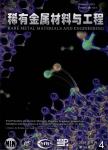Thermal Fatigue Behavior of SiC/MBAS Glass Coated Carbon/Carbon Composites
Thermal Fatigue Behavior of SiC/MBAS Glass Coated Carbon/Carbon Composites作者机构:Shenzhen University Shenzhen 518060 China Shenzhen Key laboratory of Special Functional Materials Shenzhen 518060 China Northwestern Polytechnical University Xi'an 710072 China
出 版 物:《稀有金属材料与工程》 (Rare Metal Materials and Engineering)
年 卷 期:2009年第38卷第A3期
页 面:45-49页
核心收录:
学科分类:08[工学] 0805[工学-材料科学与工程(可授工学、理学学位)] 080502[工学-材料学]
基 金:the National Natural Science Foundation of China (No. 50672059) the China Postdoctoral Science Foundation funded Project (No. 20070420771) the Project of 2007 Non-common-understanding Innovation on Sci-Technology of Shenzhen in China (natural person) the Project 200703 supported by SZU R/D Fund
摘 要:The thermal fatigue behavior of C/C composites coated with the SiC/MBAS glass (MoSi2 particle-containing boron aluminosilicate glass) coating, prepared by the two-step process of the pack cementation and procoating-sintering, was investigated in present paper. The experimental results indicated that the SiC/MBAS glass coating had an excellent thermal shock resistance in air at temperature up to 1873 K. During quick thermal cycle between 1873K and room temperature in air, the decrease of mass and mechanical property of the coated C/C composites was all slight. After thermal cycle for 50 times, the mass loss of the SiC/MBAS glass coated sample was only 0.22%; additionally, the remaining ratio of strength and modulus was no less than 95.2% and 99.4%, respectively. The decrease of the mechanical property during the thermal cycle was primarily due to the damnification of the fiber/matrix interfaces and the oxidation of the coated samples with oxygen.



